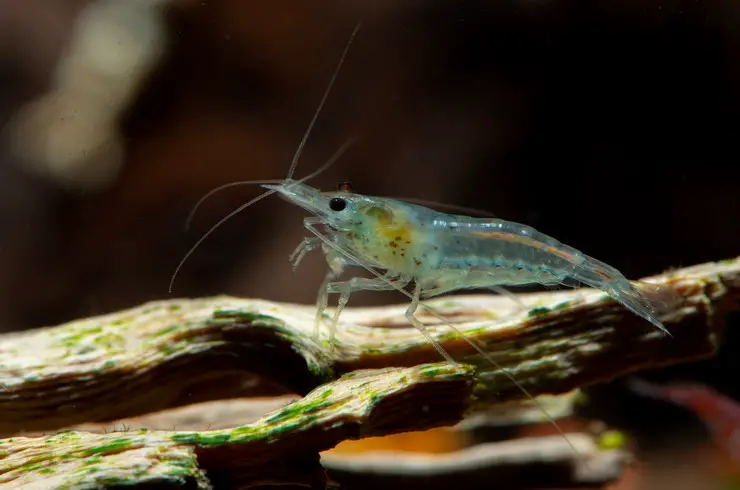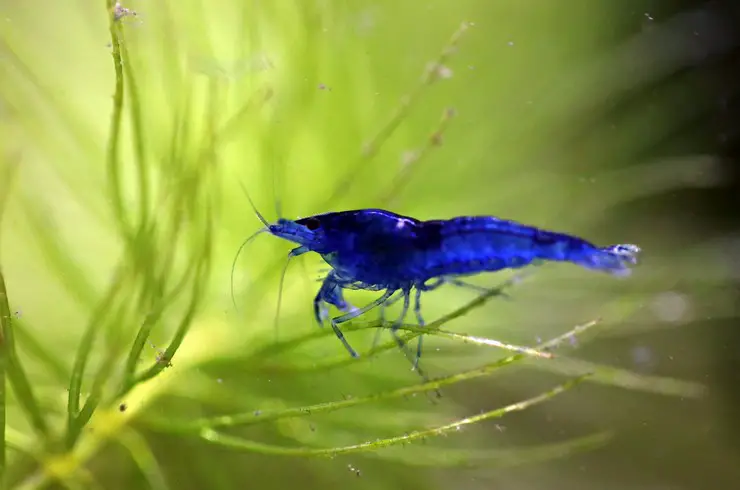Shrimp have recently become pets, but quickly gained popularity in hobbyist circles. They also did not escape the attention of breeders, who were actively engaged in the development of new color variations. Blue Dream Shrimp is the result of the work of these dedicated people. Whether it will be difficult to keep this blue beauty in a home aquarium, you will learn from our article.
General information
Blue Dream Shrimp is a breeding form of the well-known Neocaridina heteropoda shrimp. A distinctive feature of the breed is a rich blue or blue body color.
Most importantly, this amazing shrimp has taken over from the parental form the simplicity of maintenance and nutrition, as well as ease of reproduction. These features make it a great choice for beginner hobbyists.
Blue Dream Shrimp will be a spectacular decoration for a tropical aquarium or shrimp. It looks especially good with red and orange shrimps. However, these small crustaceans value more than their beauty. Shrimps are the real “orderlies” of the aquarium. They help aquarists keep their tank clean by eating food debris and algal growth on aquatic plants. Do not forget about the interesting behavior of the Blue Dream shrimp. For the bustle, when “crustaceans” examine every centimeter of the bottom or stick around a tablet of food, pushing away relatives, you can watch endlessly.
Appearance
The Blue Dream shrimp is not very large. The maximum body length does not exceed 3 cm. Females are larger than males and are brighter in color.
The body shape is typical for most shrimp. There are two sections – the cephalothorax and abdomen. The first has a dense shell that covers the gill cavities. The shrimp has five pairs of walking legs, as well as leg jaws that hold the prey and deliver it to the mouth. The antennae serve as the organ of touch. In the lower part of the abdomen, there are small legs – pleopods, which serve for movement and allow females to carry eggs.
The outer cover of Blue Dream shrimp consists of a dense substance – chitin. It is unable to stretch, so shrimp have to shed it regularly to grow. This process is called molting. Until the new cover hardens, the crustacean grows. During molting, shrimp are most vulnerable. It is recommended to leave the discarded covers in the aquarium because they are a source of nutrients.
Body-color – blue or deep blue. The intensity of the color depends on genetic characteristics and conditions of detention.
Habitat
It will not work to meet juicy and bright Blue Dream shrimps in nature, this is an artificial form obtained by the forces of breeders. The parent species – Neocaridina heteropoda – lives in slow-flowing rivers in China, Taiwan, Korea and has an almost transparent body, which helps to hide from predators.
Care and maintenance
You don’t need a large aquarium to keep Blue Dream shrimp. A small flock (10 pieces) will feel great even in containers of 10 liters or more, so they have firmly occupied their niche as residents of nano-aquariums. Given the increased jumping ability in case of fright, it is advisable to cover the aquarium with a lid or coverslip. It is also better to close large technological holes.
A layer of neutral soil is laid at the bottom of the aquarium: you can use small pebbles or sand. Blue Dream shrimp prefer dense thickets of plants, so the recommended thickness of the soil layer is at least 4 cm. It is best to use natural decorations in the design – driftwood, stones, live plants. Among the latter, a variety of mosses (Javanese, Christmas, etc.), ferns, pistia, hornwort, and cladophora are perfect.
Blue Dream shrimp love clean water, so a filter is a must. It is desirable that the filter does not create a strong current. Small internal filters (such as Tetra IN Plus) or special airlift filters (Tetra Brillant Filter) will work well, but you will need to purchase an additional compressor.
Blue Dream Shrimp are hardy crustaceans, but sensitive to high ammonia and nitrate levels. Therefore, it is recommended to plant them in the aquarium only after establishing the biological balance. Up to 20% of the aquarium volume needs to be changed weekly.
It is not recommended to keep Blue Dream shrimp in very soft water. The low mineral content will make the shell-less durable.
Important! Shrimp do not tolerate copper compounds, so you need to be careful when using certain medications.
Compatibility
The ideal option for placing Blue Dream shrimp will be a species of shrimp. However, these crustaceans are peaceful in nature and will not harm other inhabitants of the aquarium.
It is highly undesirable to combine Blue Dream shrimp with other neocaridins. The fact is that almost all species easily interbreed with each other, this will ultimately lead to the loss of bright colors in subsequent generations.
Among the fish, guppies, neons, micro-assemblies, small irises, ototsinkluses will become excellent neighbors.
In no case should you add large cichlids to the shrimp, which will be ready to eat blue shrimp with pleasure? Even relatively calm species, such as apistograms and scalars, can nibble on “crustaceans” a little. Helena’s predatory snails will also like to eat Blue Dream babies.
Feeding Blue Dream Shrimp
Feeding Blue Dream shrimp at home will not be difficult. Often they have enough “pasture” food, such as algae and leftover flakes for fish. However, from time to time, the shrimp need additional feeding. In such cases, it is best to use quality dry food for shrimp (Tetra Crusta) or bottom fish (Tetra WaferMix). They are fully balanced, rich in selected proteins, and contain the algae Spirulina, which is essential for proper digestion and supporting the immune system. Since the diet is dominated by plant products, it is not recommended to feed the shrimp with high-protein live or frozen food, they can lead to gastrointestinal problems or become a source of contamination of the aquarium.
You need to feed Blue Dream shrimp once a day. The supplied amount of feed should be completely consumed within a few hours.
Reproduction and breeding
The breeding process for Blue Dream shrimp is not at all complicated. Like many other neocaridins, they reproduce easily on their own, without creating any special conditions. Distinguishing the female from the male is also not difficult. Males are smaller, less bright, there is no saddle on the abdominal legs, in which females hatch eggs.
The female ready for breeding begins to release special chemicals into the water – pheromones, which attracts males. After courtship-dancing, the male leaves the male reproductive cell bag near the reproductive opening. Further, the emerging eggs are fertilized, and subsequently, all the care falls on the mother: she carries the caviar on her abdominal legs, takes care of it, cleans it of dirt, removes dead eggs, creates a stream of water to provide oxygen. The fecundity of a female can be 20-30 eggs.

